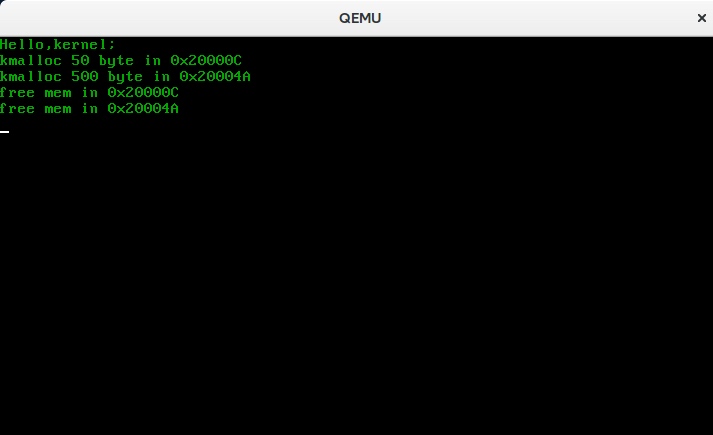看了一眼James的堆教程,吓得我直接Ctrl+W,代码太多,等我看完估计得到天荒地老。所以我找了一篇更简单的教程。它的堆管理讲的很清晰,只有少数几个函数,但是却实现了基本的功能。不过代码的某些功能和我的分页机制不兼容,所以我改了它的代码,实现起来更加简单。
堆设计
这个堆的设计和Linux的不同,它采用双向链表的形式。
1
2
3
4
5
6
7
8
9
|
typedef struct header{
struct header *prev;
struct header *next;
u32 allocated : 1;
u32 length : 31;
}header_t;
|
这是堆的头部,prev指向前面的堆,next指向后面的堆,allocated表示当前堆是否在使用,length表示当前堆的长度,就跟Linux堆中的size差不多。
堆分配
简单说一下kmalloc的流程,cur_header永远指向第一个分配的堆,之后分配的时候会通过第一个堆的next指针依次往下找,直到找到allocated为0的堆块,然后在此处创建新堆的头部,并将堆的管理区域(mem)地址返回。
这样的分配机制有性能缺陷,如果堆特别多的话找起来会非常慢,除非前面的堆被free过,不过为了简单就先凑合用。
为了方便,我保留了原作者的注释,并添加了一些新注释。
1
2
3
4
5
6
7
8
9
10
11
12
13
14
15
16
17
18
19
20
21
22
23
24
25
26
27
28
29
30
31
32
33
34
35
36
37
38
39
40
41
42
43
44
45
46
47
48
49
50
51
52
53
54
55
56
57
58
|
void init_heap(){
heap_first = 0;
}
void *kmalloc(u32 len){
len += sizeof(header_t);
header_t *cur_header = heap_first;
header_t *prev_header = 0;
while (cur_header) {
if (cur_header->allocated == 0 && cur_header->length >= len) {
split_chunk(cur_header, len);
cur_header->allocated = 1;
return (void *)((u32)cur_header + sizeof(header_t));
}
prev_header = cur_header;
cur_header = cur_header->next;
}
u32 chunk_start;
if (prev_header) {
chunk_start = (u32)prev_header + prev_header->length;
} else {
chunk_start = HEAP_START;
heap_first = (header_t *)chunk_start;
}
cur_header = (header_t *)chunk_start;
cur_header->prev = prev_header;
cur_header->next = 0;
cur_header->allocated = 1;
cur_header->length = len;
if (prev_header) {
prev_header->next = cur_header;
}
return (void*)(chunk_start + sizeof(header_t));
}
|
堆释放
堆释放比较简单,就是将其allocated置为0,这样等到kmalloc遍历的时候会就找到这个块。glue_chunk用来合并前后已经被释放的块,相当于ptmalloc中的unlink功能。
1
2
3
4
5
6
7
8
9
10
11
12
13
14
15
16
17
18
19
20
21
22
23
24
25
26
27
28
29
30
31
32
33
34
35
36
|
void kfree(void *p)
{
header_t *header = (header_t*)((u32)p - sizeof(header_t));
header->allocated = 0;
glue_chunk(header);
}
void glue_chunk(header_t *chunk)
{
if (chunk->next && chunk->next->allocated == 0) {
chunk->length = chunk->length + chunk->next->length;
if (chunk->next->next) {
chunk->next->next->prev = chunk;
}
chunk->next = chunk->next->next;
}
if (chunk->prev && chunk->prev->allocated == 0) {
chunk->prev->length = chunk->prev->length + chunk->length;
chunk->prev->next = chunk->next;
if (chunk->next) {
chunk->next->prev = chunk->prev;
}
chunk = chunk->prev;
}
}
|
测试
1
2
3
4
5
6
7
8
9
10
11
12
13
14
15
16
17
18
19
20
21
22
23
24
25
26
27
28
29
30
|
int kmain(void){
console_clear();
init_gdt();
init_idt();
printk("Hello,kernel;\n");
init_timer(200);
initialise_paging();
void *addr1 = kmalloc(50);
printk("kmalloc 50 byte in 0x%X\n", addr1);
void *addr2 = kmalloc(500);
printk("kmalloc 500 byte in 0x%X\n", addr2);
printk("free mem in 0x%X\n", addr1);
kfree(addr1);
printk("free mem in 0x%X\n", addr2);
kfree(addr2);
return 0;
}
|

参考资料
hurlex <十一> 内核堆管理的实现
